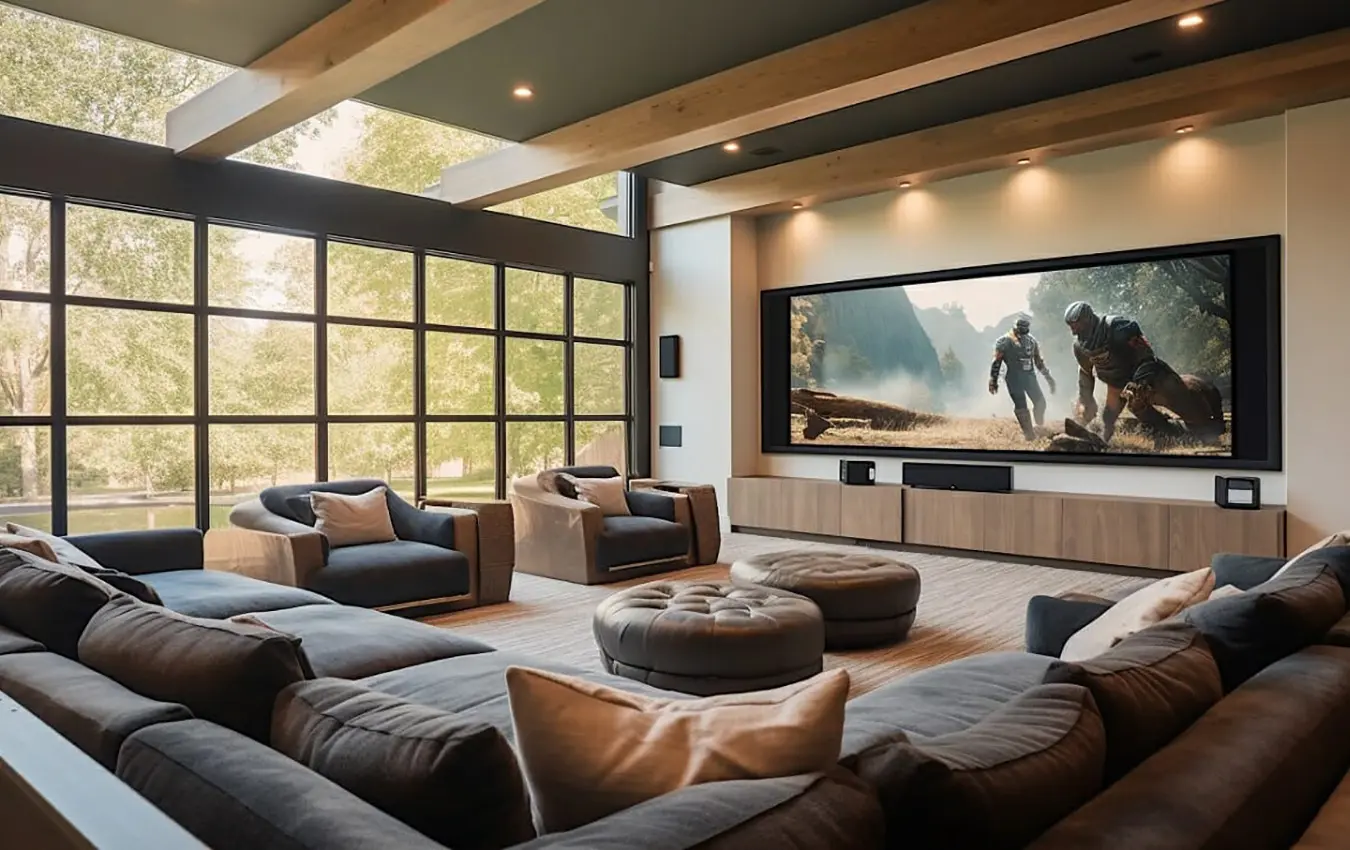Are you struggling to find the perfect ceiling light for your space? Look no further! In this guide, we will provide you with expert tips on how to select the perfect ceiling light, as well as valuable insights on installation and placement. The right ceiling light can transform any room, creating the perfect ambiance and enhancing the overall aesthetic. But with so many options available, it can be overwhelming to make the correct choice. That’s where we come in. Our team of experts has curated a comprehensive list of considerations to help you navigate the world of ceiling lights. From understanding different types of lighting fixtures to determining the ideal height and size for your space, we’ve got you covered. Whether you’re revamping your living room, kitchen, or bedroom, this guide will empower you to make informed decisions and create a well-lit and beautiful environment that truly reflects your style and personality. So, let’s dive in and shed some light on choosing the perfect ceiling light!
Importance of Choosing the Right Ceiling Light
The importance of selecting the right ceiling light cannot be overstated. Lighting plays a crucial role in setting the mood and atmosphere of a room. It can create a warm and inviting space or a bright and energetic one. The proper ceiling light can also highlight architectural features, artwork, or focal points in a room. It is essential to consider the function of the space when selecting a ceiling light. For example, a kitchen may require bright and focused lighting for food preparation, while a bedroom may benefit from a softer, more calming light. Additionally, the style and design of the ceiling light should complement the overall aesthetic of the room. Whether you prefer modern, traditional, or transitional styles, selecting a ceiling light that aligns with your design preferences will ensure a cohesive and visually pleasing space.
When considering the right ceiling light, it is also important to think about energy efficiency. LED lights are a popular choice due to their long lifespan and low-energy consumption. Not only will you save on electricity bills, but you’ll also contribute to a greener environment. With the advancements in LED technology, you can now find a wide variety of LED ceiling lights that offer different color temperatures and dimming capabilities. This allows you to tailor the lighting to suit your needs and preferences.
Choose Premier Electrical Services for all your ceiling lighting planning and installation needs and experience the difference that expert service from our professionals can make. Call us right now at 954-900-1696 or fill out an online form!
Types of Ceiling Lights
Ceiling lights come in various types, each offering unique features and benefits. Understanding the different types of ceiling lights will help you make an informed decision based on your specific requirements. Here are some common types of ceiling lights:
Flush Mount Ceiling Lights
Flush mount ceiling lights are versatile and suitable for rooms with low ceilings. These lights are installed directly against the ceiling, providing a seamless and compact lighting solution. Flush mount lights come in a variety of styles, from simple and understated to decorative and elaborate designs.
Semi-Flush Mount Ceiling Lights
Similar to flush mount lights, semi-flush mount lights are also installed against the ceiling. However, they hang slightly lower, creating a more prominent presence in the room. Semi-flush mount lights are ideal for rooms with higher ceilings, as they add a touch of elegance and sophistication.
Pendant Lights
Pendant lights are suspended from the ceiling by a cord, chain, or rod. They hang lower than other types of ceiling lights, making them a great choice for providing focused task lighting or creating an eye-catching centerpiece. Pendant lights are available in various sizes, shapes, and styles, allowing you to find the perfect match for your space.
Chandeliers
Chandeliers are a statement piece that adds drama and elegance to any room. These grand lighting fixtures are typically made up of multiple arms and adorned with crystals or other decorative elements. Chandeliers are commonly used in dining rooms, entryways, and living rooms, creating a captivating focal point.
Recessed Lights
Recessed lights, also known as can light or down lights, are installed into the ceiling, creating a clean and streamlined look. These lights are popular in contemporary and minimalist designs, as they provide a subtle and unobtrusive lighting solution. Recessed lights can be used to highlight specific areas or provide overall ambient lighting.
Track Lighting
Track lighting consists of multiple adjustable fixtures mounted on a track. This type of lighting allows you to direct the light to specific areas or objects, making it ideal for highlighting artwork, architectural features, or task areas. Track lighting offers flexibility and versatility, as the fixtures can be easily repositioned to suit your changing needs.
Determining the right type of ceiling light for your space depends on several factors, including the size and height of the room, the desired lighting effect, and your personal style preferences. Consider how each type of ceiling light will complement the overall design and function of the room before making your decision.
Factors to Consider When Choosing a Ceiling Light
When choosing a ceiling light, there are various factors to consider, ensuring that it meets your specific needs and preferences. By taking these factors into account, you can make an informed decision that will result in a well-lit and visually appealing space. Let’s explore some essential factors to consider when choosing a ceiling light:
Room Size and Ceiling Height
The size of the room and the height of the ceiling are crucial factors in determining the appropriate size and type of ceiling light. In larger rooms, you may need multiple light sources or larger fixtures to adequately illuminate the space. Similarly, rooms with higher ceilings may require lights that hang lower to provide the desired lighting effect.
Lighting Intensity and Color Temperature
Consider the desired lighting intensity and color temperature for the room. Bright and cool-toned lights are suitable for task-oriented areas, such as kitchens and home offices, where visibility is essential. On the other hand, warm and soft lighting creates a cozy and inviting atmosphere in living rooms, bedrooms, and dining areas.
Style and Design
The style and design of the ceiling light should complement the overall aesthetic of the room. Consider the existing decor, furniture, and architectural elements when selecting a ceiling light. Whether your style is contemporary, traditional, or eclectic, there are plenty of options available to suit your taste.
Maintenance and Durability
Consider the maintenance requirements and durability of the ceiling light. LED lights are known for their long lifespan and low maintenance needs, making them a popular choice among homeowners. Additionally, consider the quality and materials of the light fixture to ensure it will withstand daily use and maintain its appearance over time.
Budget
Set a budget for your ceiling light purchase. With a wide range of options available, there is a ceiling light to fit every budget. Consider the features and benefits that are most important to you, and allocate your budget accordingly.
By considering these factors, you can narrow down your options and choose a ceiling light that meets your specific requirements and enhances the overall ambiance of your space.
Determining the Right Size and Height for Your Ceiling Light
Determining the right size and height for your ceiling light is crucial to achieve the desired lighting effect and visual impact. Here are some guidelines to help you determine the appropriate size and height for your ceiling light:
1. Room Size
Consider the size of the room when selecting a ceiling light. For smaller rooms, select a light fixture that is proportionate to the space to avoid overwhelming the room. In larger rooms, opt for larger fixtures or multiple light sources to ensure adequate lighting coverage.
2. Ceiling Height
The height of the ceiling plays a significant role in determining the appropriate height for your ceiling light. As a general rule, the bottom of the light fixture should be at least 7 feet from the floor to avoid obstructing the line of sight and to provide ample headroom.
3. Dining Areas
In dining areas, the bottom of the chandelier or pendant light should typically be 30 to 36 inches above the tabletop. This allows for comfortable conversation and prevents the light from shining directly into diners’ eyes.
4. Entryways and Foyers
In entryways and foyers, the ceiling light should create a welcoming and visually appealing focal point. Consider the height of the ceiling and the scale of the space when choosing a chandelier or pendant light. The light fixture should be proportionate to the entryway and hang at an appropriate height to make a statement without overpowering the space.
5. Bedrooms and Living Rooms
In bedrooms and living rooms, the height and size of the ceiling light depend on personal preference and the desired lighting effect. For lower ceilings, flush mount or semi-flush mount lights are a practical choice. For higher ceilings, consider pendant lights or chandeliers that hang at an appropriate height to create an inviting and visually stunning atmosphere.
Remember to take measurements and consider the scale and proportion of the room when determining the size and height for your ceiling light. By doing so, you can ensure that the light fixture enhances the overall aesthetic and functionality of the space.
Proper Placement of Ceiling Lights in Different Rooms
The proper placement of ceiling lights in different rooms is essential to achieve optimal lighting and create the desired ambiance. Each room has its unique lighting requirements, and understanding how to position the ceiling lights will help you maximize their effectiveness. Let’s explore the proper placement of ceiling lights in different rooms:
Living Room
In the living room, the ceiling light should provide overall ambient lighting. Consider installing a central light fixture, such as a chandelier or a large pendant light, to illuminate the entire room. If the living room has multiple seating areas or features specific task areas, such as a reading nook or a TV viewing area, consider incorporating additional lighting sources, such as floor lamps or table lamps, to provide focused lighting where needed.
Kitchen
In the kitchen, the ceiling light should provide bright and focused lighting for food preparation and cooking. Consider installing recessed lights or track lighting above work surfaces, such as countertops and the stove. Pendant lights are also a popular choice for kitchen islands or dining areas within the kitchen. Ensure that the lighting is evenly distributed and free from shadows to facilitate safe and efficient cooking.
Dining Room
In the dining room, the ceiling light should be positioned above the dining table to create a focal point and provide ample lighting for meals and gatherings. The bottom of the chandelier or pendant light should typically hang 30 to 36 inches above the tabletop. This ensures that the light is distributed evenly and does not obstruct the line of sight between diners.
Bedroom
In the bedroom, the ceiling light should provide a soft and relaxing ambiance. Consider installing a flush mount or semi-flush mount light fixture in the center of the room to provide overall ambient lighting. Additionally, incorporate task lighting, such as bedside table lamps or wall-mounted reading lights, to provide focused lighting for activities such as reading or getting dressed.
Bathroom
In the bathroom, the ceiling light should provide bright and even lighting for grooming and personal care tasks. Consider installing recessed lights or flush mount lights around the vanity area to eliminate shadows and ensure proper visibility. If space permits, incorporate additional lighting sources, such as wall sconces or pendant lights near the mirror, to enhance the overall lighting effect.
Properly placing ceiling lights in different rooms will enhance the functionality and aesthetics of the space. Consider the specific lighting requirements of each room and incorporate multiple light sources to create a well-lit and inviting environment.
Installation Process for Ceiling Lights
Installing a ceiling light may seem like a daunting task, but with the right tools and instructions, it can be a straightforward process. Here is a general installation process for ceiling lights:
1. Turn off the power
Before starting any electrical work, turn off the power to the circuit you will be working on. Locate the circuit breaker or fuse box and switch off the corresponding circuit.
2. Remove the old fixture (if applicable)
If you are replacing an existing ceiling light, carefully remove the old fixture by disconnecting the wires and removing any screws or mounting brackets.
3. Prepare the mounting bracket
If your new ceiling light requires a mounting bracket, assemble it according to the manufacturer’s instructions. Ensure that the bracket is securely attached to the ceiling.
4. Connect the wires
Carefully connect the wires from the ceiling to the corresponding wires on the light fixture. Match the colors of the wires (usually black to black, white to white, and green or copper to the ground wire).
5. Secure the light fixture
Once the wires are connected, gently push the excess wires into the electrical box and secure the light fixture to the mounting bracket using the provided screws.
6. Install the light bulbs
Install the appropriate light bulbs into the fixture, following the manufacturer’s recommendations. Ensure that the bulbs are securely in place.
7. Test the light
Turn the power back on and test the light to ensure it is functioning correctly. If the light does not turn on or if there are any issues, double-check the wiring connections and consult a professional if needed.
8. Attach any additional accessories
If your ceiling light comes with additional accessories, such as a diffuser or decorative elements, attach them according to the manufacturer’s instructions.
It is important to note that electrical work should only be performed by individuals with the necessary knowledge and skills. If you are unsure or uncomfortable with the installation process, it is recommended to hire a professional electrician to ensure a safe and proper installation.
Common Mistakes to Avoid When Installing Ceiling Lights
When installing ceiling lights, it is essential to avoid common mistakes that can compromise safety and functionality. Here are some common mistakes to avoid:
Overlooking Safety Precautions
Always turn off the power to the circuit before starting any electrical work. Neglecting this step can result in electrical shock or injury. Additionally, use appropriate safety gear, such as gloves and safety glasses, to protect yourself during the installation process.
Incorrect Wiring
Ensure that the wires are properly connected and securely fastened. Incorrect wiring can lead to electrical issues or cause the light fixture to malfunction. If you are unsure about the wiring, consult a professional electrician.
Overloading the Circuit
Be mindful of the electrical load on the circuit. If you are installing multiple ceiling lights or other electrical fixtures on the same circuit, ensure that the circuit can handle the load. Overloading the circuit can result in tripped breakers or potential fire hazards.
Insufficient Support
Properly support the light fixture to prevent it from falling or becoming unstable. Ensure that the mounting bracket is securely attached to the ceiling and that the light fixture is properly fastened to the bracket.
Ignoring Manufacturer’s Instructions
Always refer to the manufacturer’s instructions when installing a ceiling light. Each light fixture may have specific requirements and installation steps that should be followed for optimal performance and safety. Ignoring these instructions can lead to improper installation, which may result in electrical hazards or damage to the fixture itself. It is crucial to understand the unique specifications of each light fixture, such as the recommended wattage, mounting method, and any additional tools or hardware needed for installation. By disregarding the manufacturer’s instructions, you risk voiding any warranties or guarantees associated with the product.
Conclusion
Ceiling lights are an integral part of the home, and they serve many purposes. They’re a great way to add different lighting fixtures to your space, and they can be placed over a dining table or near the windows for added ambient light. Ceiling lights can also help brighten up darker areas of a room, or highlight-specific things in your home layout. In short, the options really are endless!
Ultimately, the choice is yours. With this guide, you should now have the fundamental knowledge to compare your options and find the perfect ceiling light for your space. This practical advice will serve as a starting point on your journey to find the best ceiling light for your needs, while also considering other design elements like color, style, size, and placement. Now it’s time to bring your vision into full reality.
Premier Electrical Services team of experienced electricians can help you design and install ceiling lights to accentuate the interior design of rooms and bring comfort to your home. Contact us today to learn more about our ceiling light installation services. Call 954-900-1696 or apply online on the website!
Check out the latest news:
- 10 Electrical Hazards of DIY Generator Installation
- Transform Your Living Space: The Benefits of Home Theater Systems
- How to Choose the Right Lighting Fixtures for Your Home or Business
- Don’t Be Left in the Dark: Why Homeowners Should Consider Premier Electrical Services for Backup Generator Installation
- Residential Electrical Wiring: Why You Need a Professional Electrician






